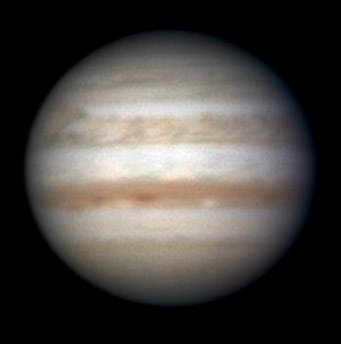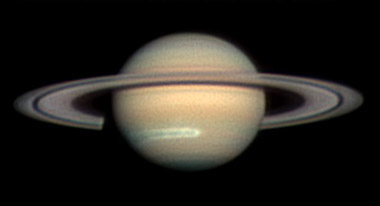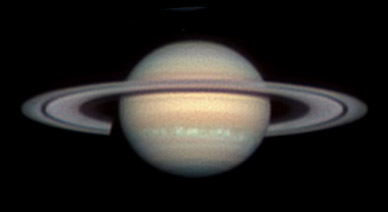
"Jupiter is getting more difficult now," writes imager Christopher Go in the Philippines. He caught this view of the re-formed South Equatorial Belt (above center) in twilight on February 11th just before Jupiter disappeared behind his building's roof.
The Great Red Spot is at left. "The SEB is already red in this area and it is also very turbulent," he notes. "The NEB is dark red, and note the dark and white ovals on the NEBn." South is up.
Friday, February 11
Saturday, February 12
Sunday, February 13
Monday, February 14
Tuesday, February 15
Wednesday, February 16
Thursday, February 17
Friday, February 18
Saturday, February 19
Sky at a Glance is now an iPhone app! Put S&T SkyWeek on your iPhone, iPad, or iPod Touch and get the above listings anytime, anywhere — with interactive sky maps! Tap a button to see the scene described, customized for your location worldwide. From there you can scroll the view all around the sky, zoom in or out, change to any time or date, and turn on animation. Now includes This Week's Planet Roundup below.
Go to Apple's iTunes store from your device and buy S&T SkyWeek — just 99 cents!
Want to become a better amateur astronomer? Learn your way around the constellations. They're the key to locating everything fainter and deeper to hunt with binoculars or a telescope.
For an easy-to-use constellation guide covering the whole evening sky, use the big monthly map in the center of each issue of Sky & Telescope, the essential magazine of astronomy. Or download our free Getting Started in Astronomy booklet (which only has bimonthly maps).

The Pocket Sky Atlas plots 30,796 stars to magnitude 7.6 — which may sound like a lot, but that's less than one star in an entire telescopic field of view, on average. By comparison, Sky Atlas 2000.0 plots 81,312 stars to magnitude 8.5, typically one or two stars per telescopic field. Both atlases include many hundreds of deep-sky targets — galaxies, star clusters, and nebulae — to hunt among the stars.
Sky & Telescope
Once you get a telescope, to put it to good use you must have a detailed, large-scale sky atlas (set of charts). The standards are the Pocket Sky Atlas, which shows stars to magnitude 7.6; the larger Sky Atlas 2000.0 (stars to magnitude 8.5); and the even larger and deeper Uranometria 2000.0 (stars to magnitude 9.75). And read how to use sky charts effectively.
You'll also want a good deep-sky guidebook, such as Sky Atlas 2000.0 Companion by Strong and Sinnott, or the more detailed and descriptive Night Sky Observer's Guide by Kepple and Sanner, or the classic if dated Burnham's Celestial Handbook.
Can a computerized telescope take their place? I don't think so — not for beginners, anyway, and especially not on mounts that are less than top-quality mechanically. As Terence Dickinson and Alan Dyer say in their Backyard Astronomer's Guide, "A full appreciation of the universe cannot come without developing the skills to find things in the sky and understanding how the sky works. This knowledge comes only by spending time under the stars with star maps in hand."
This Week's Planet Roundup

Saturn's new white spot now "looks like a comet," writes Christopher Go. This image exaggerates its contrast, but even visually "it is very distinct" in Go's 11-inch scope. He also noted that the North Equatorial Belt "is red and distinct now." South here is up.
Click for animation of several images spanning 33 minutes of Saturn's rotation. This one was shot at 18:50 UT Feb. 6, 2011, when the System III central-meridian longitude was 50°.
And see an even more awesome Cassini image.
Mercury, Mars, and Neptune are hidden behind the glare of the Sun.
Venus (magnitude –4.2, in Sagittarius) shines as the "Morning Star" in the southeast before and during dawn.
Jupiter (magnitude –2.1, at the Pisces-Cetus border) shines brightly in the west-southwest at dusk and sets in the west around 9 p.m. Get your telescope on it in late twilight while it's still high. Jupiter has shrunk to only 35 arcseconds wide, but keep watch on its South Equatorial Belt re-forming.
Saturn (magnitude +0.6, in Virgo) rises around 10 p.m., but it's best seen in a telescope at its highest in the south in the early-morning hours (it transits around 3 a.m.). Don't confuse Saturn with Spica 8° or 9° below it during evening, and lower left of it before dawn.

The other side of Saturn, imaged by Go on February 11th; the System III central meridian here is 264°. This is the side of Saturn where the white disturbance started, he notes. "Even though the head of the [disturbance] is on the other side of the planet, this area is still bright. The head has basically moved more than half around the planet now. The South Equatorial Belt can be seen just south of the ring." South is up.
In a telescope, Saturn's new white spot has spread into a double streak far around the planet, as seen here. Saturn's rings are 10° from edge on, their maximum for this year. See how many of Saturn's satellites you can identify in your scope using our Saturn's Moons tracker.
Uranus (magnitude 5.9) is about 6° west (lower right) of Jupiter.
All descriptions that relate to your horizon — including the words up, down, right, and left — are written for the world's mid-northern latitudes. Descriptions that also depend on longitude (mainly Moon positions) are for North America. Eastern Standard Time (EST) equals Universal Time (also known as UT, UTC, or GMT) minus 5 hours.
To be sure to get the current Sky at a Glance, bookmark this URL:
http://SkyandTelescope.com/observing/ataglance?1=1
If pictures fail to load, refresh the page. If they still fail to load, change the 1 at the end of the URL to any other character and try again.
 0
0
Comments
You must be logged in to post a comment.